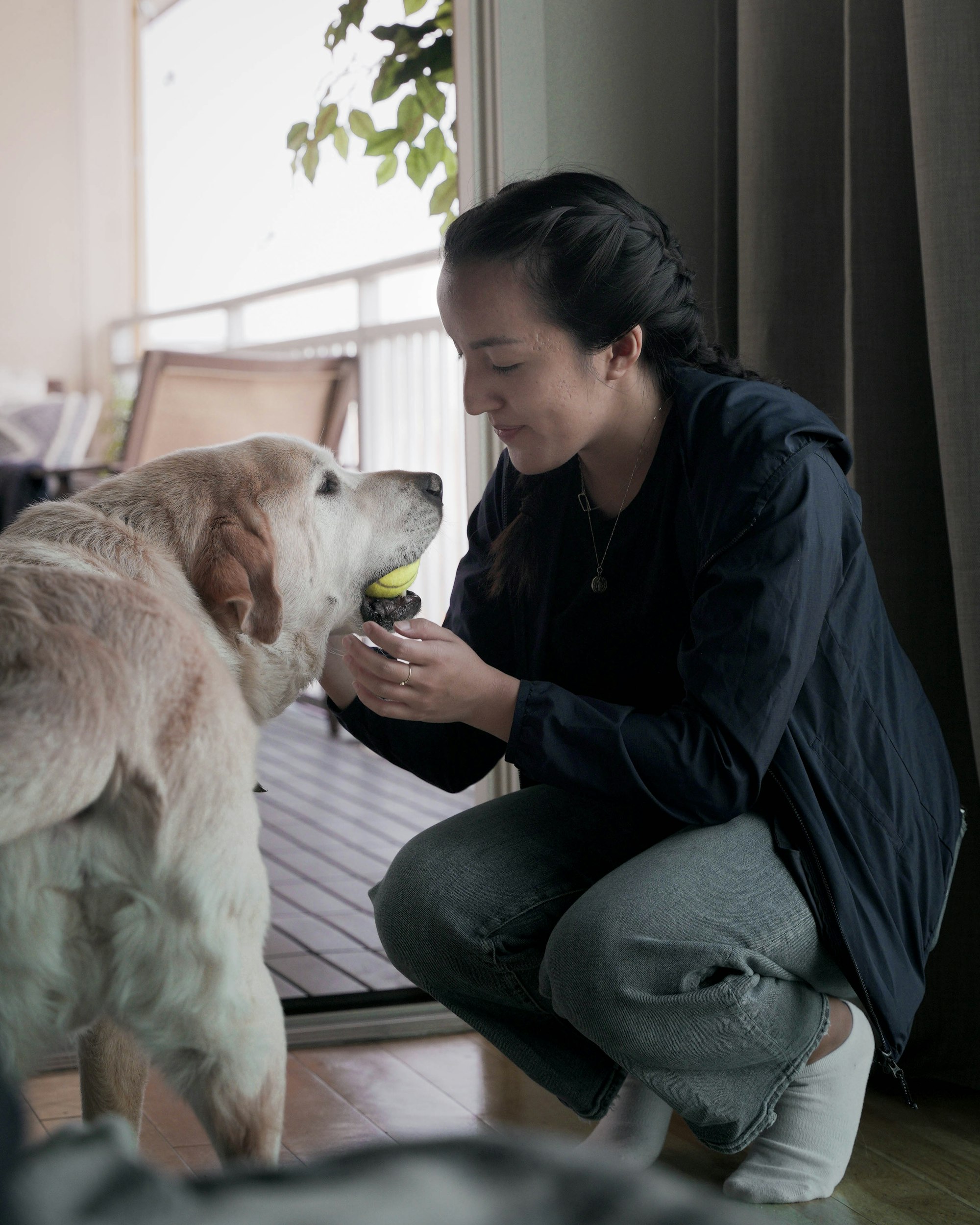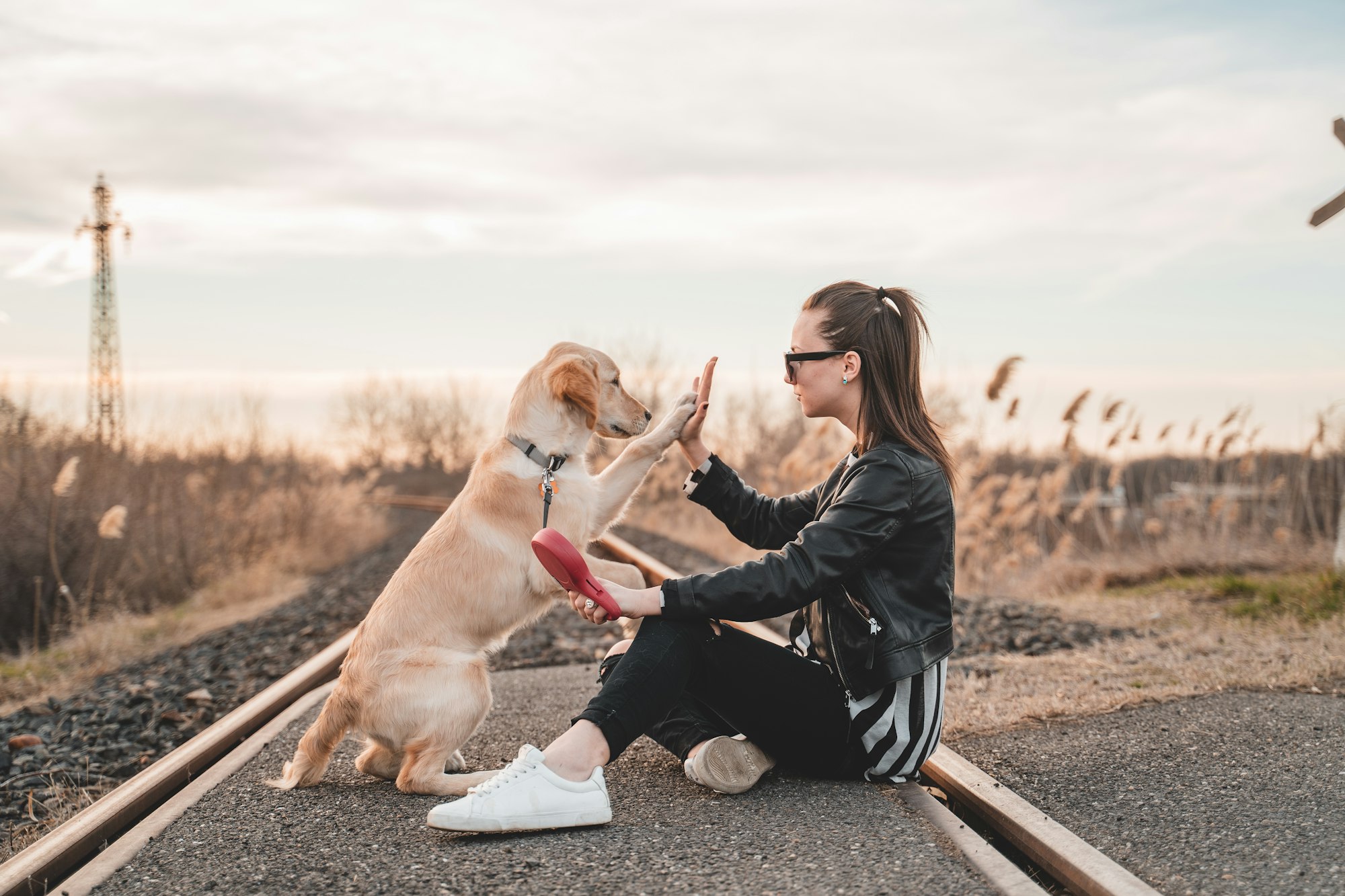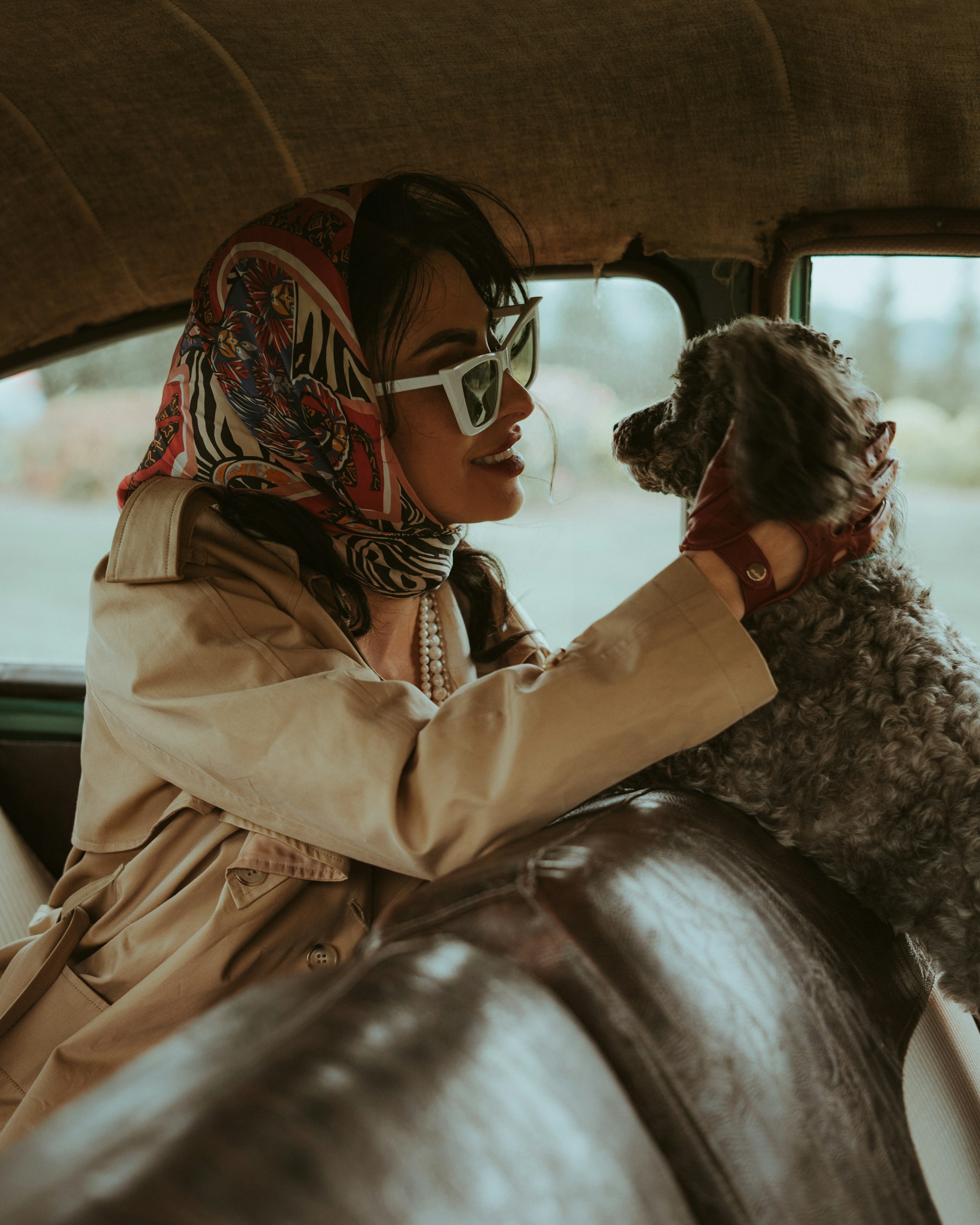Being the alpha or pack leader to your dog is essential for a harmonious relationship and effective training. It helps establish a sense of order, respect, and trust between you and your furry companion. Here, we will explore practical ways to show your dog that you're the alpha and ensure a healthy bond based on trust and respect.

Establishing Leadership and Safety with the Fi Dog Collar
Being a consistent, trustworthy leader is essential in building a strong bond with your dog, and the Fi Dog Collar is here to support that journey. Just as you establish rules and boundaries for your furry companion, the Fi Dog Collar offers reliable GPS tracking to keep them safely within your established boundaries. Its advanced technology provides real-time alerts, ensuring you know exactly where your dog is at all times.
By integrating the Fi Dog Collar into your routine, you not only reinforce your role as the guide but also demonstrate your commitment to their well-being. The collar’s features help you understand your dog’s activity levels and needs, enabling you to lead with empathy, consistency, and confidence. Explore how the Fi Dog Collar can enhance your leadership and strengthen your bond at TryFi.com today!
Understanding Leadership in Human-Dog Relationships
Modern dog behavior science suggests that the notion of an 'alpha' or 'pack leader' in the human-dog dynamic is outdated. Dogs are highly social animals, and their relationships with humans are based on trust, cooperation, and communication rather than dominance. Here's a more nuanced approach to leadership:
- Partnership and Trust: Building a relationship with your dog based on partnership and trust is more beneficial than asserting dominance. Focus on understanding your dog's needs, emotions, and signals to foster a strong bond.
- Consistency and Clarity: Consistency in rules and expectations is key, but it's equally important to ensure that your dog understands what is expected. Use clear, consistent commands and reward-based training to guide behavior.
- Communication Through Training: Modern training techniques emphasize positive reinforcement and reward-based methods. These approaches encourage your dog to learn and make choices that lead to rewards, rather than obeying out of fear or submission.
- Leadership Through Guidance: Instead of asserting dominance, position yourself as a guide for your dog. Lead by example and set boundaries in a way that's respectful and understanding of your dog's perspective.
- Mutual Respect: Respect is a two-way street. Show your dog respect by attending to their needs, providing mental and physical stimulation, and listening to their cues. This respect will be reciprocated through cooperative behavior.
Building Trust and Respect
Trust and respect are foundational to a healthy human-dog relationship. Here are some ways to strengthen these aspects:
- Understanding and Responding to Needs: Pay close attention to your dog's physical and emotional needs. Ensuring they have adequate exercise, mental stimulation, and social interaction is crucial.
- Positive Reinforcement: Reinforce desired behaviors with treats, praise, or playtime. This positive approach builds a stronger, more affectionate bond.
- Empathy and Patience: Recognize that all dogs are individuals with their own feelings and learning curves. Approach training and daily interactions with patience and empathy.
Setting Rules and Boundaries
Setting boundaries is essential, but it's important to do so with kindness and understanding:
- Positive Training Methods: Use reward-based training to encourage the behaviors you want, instead of punishing unwanted behaviors. This method is more effective and builds a positive relationship.
- Clear Communication: Make sure your commands are consistent and that your dog understands what you're asking. Use body language and tone of voice to communicate effectively.
- Respectful Correction: If your dog makes a mistake, guide them gently to the correct behavior. Avoid harsh corrections, as they can erode trust.
Providing Structure and Guidance
Structure and guidance help your dog feel secure and understand their environment:
- Routine and Predictability: Maintain a regular schedule for feeding, walks, and playtime. Predictability helps your dog feel secure.
- Engaging Activities: Include activities that mentally and physically engage your dog, such as puzzle toys, training games, and interactive play.
- Learning Opportunities: Regular, short training sessions can be a fun and rewarding way to strengthen your bond and reinforce desirable behaviors.
Maintaining a Calm and Positive Environment
Your demeanor greatly influences your dog:
- Calm Leadership: Dogs are sensitive to our emotions. Maintaining a calm and positive demeanor encourages your dog to respond in kind.
- Positive Atmosphere: Creating a positive environment for your dog means using encouragement and rewards to motivate behavior, rather than fear or intimidation.
By incorporating these updated approaches, your article will reflect current understandings of dog behavior and training, emphasizing a relationship built on mutual respect and understanding rather than dominance.

Building trust and respect is crucial for establishing a strong bond with your dog. Here are some key steps to follow:
Consistency and Clear Communication
Dogs thrive on consistency. Be consistent with your commands, expectations, and daily routines. This helps your dog understand what is expected of them and creates a sense of stability. Additionally, use clear and concise dog communication when giving commands. Use the same words and gestures consistently to avoid confusion.
Spending Quality Time
Dedicate quality time to bond with your dog. Engage in activities they enjoy, such as playing fetch, going for walks, or even simple grooming sessions. This one-on-one time helps build trust, deepens your connection, and shows your dog that you value their companionship.
Understanding Their Body Language
Pay attention to your dog's body language to better understand their needs and emotions. This allows you to respond appropriately and build trust. Learn to recognize signs of stress, fear, or discomfort, and create a safe and supportive environment for your dog.

Setting Rules and Boundaries
Setting clear rules and boundaries is essential for maintaining order and establishing your role as a leader. Here's how to do it effectively:
Establishing a Routine
Dogs thrive on routine and structure. Set a consistent schedule for feeding, exercise, playtime, and rest. This routine helps your dog understand the expectations and boundaries within your household.
Enforcing Basic Commands
Teach your dog basic commands such as sit, stay, come, and leave it. Consistently reinforce these commands during daily interactions. This establishes your authority and helps your dog understand their role in the pack.
Consistent Correction
When your dog misbehaves or breaks a rule, correct them in a firm but fair manner. Use a stern voice or a gentle tug on the leash to redirect their behavior. Consistency is key to reinforcing the boundaries and expectations you've set.
Avoiding Mixed Signals
It's crucial to avoid sending mixed signals to your dog. For example, if you don't want them on the furniture, be consistent in enforcing that rule. Allowing them on the couch occasionally can confuse them and blur the boundaries you've established.
Providing Structure and Guidance
Providing structure and guidance is essential for establishing yourself as the alpha and helping your dog thrive. Here are some key steps to follow:
Leadership in Daily Activities
Take the lead in daily activities to reinforce your role as the alpha. For example, when going through doorways, make sure you walk ahead of your dog. During mealtime, have your dog wait patiently for your signal before eating. By leading these activities, you establish yourself as the decision-maker and guide for your dog.
Proper Leash Walking
Leash walking is an important activity that requires structure and guidance. Always walk your dog on a loose leash, with you in control of the pace and direction. Avoid allowing your dog to pull or lead the way. By maintaining control during walks, you assert your leadership and reinforce your alpha status.
Consistent Training and Commands
Regular training sessions are crucial for providing structure and guidance. Teach your dog basic commands such as sit, stay, and heel, and consistently reinforce these commands during walks and daily interactions. This helps your dog understand their role and reinforces your position as the leader.
Structured Play and Exercise
Incorporate structured play and exercise sessions into your routine. Engage in activities that encourage your dog to follow your lead, such as playing fetch or practicing obedience commands during playtime. This not only provides physical exercise but also reinforces your role as the one in charge.
Setting Boundaries
Establish clear boundaries within your home and during interactions with your dog. For example, designate certain areas as off-limits, such as bedrooms or furniture, if desired. Consistently reinforce these boundaries by redirecting your dog when they cross them. This helps your dog understand the rules and reinforces your role as the one who sets them.
By providing structure and guidance, you create a stable and balanced environment for your dog. This allows them to feel secure, understand their place in the pack, and develop a stronger bond with you as their alpha.

Maintaining Calm and Assertive Energy
Maintaining calm and assertive energy is vital when establishing yourself as the alpha and effectively communicating with your dog. Here are some tips to help you achieve this:
Confidence and Body Language
Dogs respond to confident leaders. Stand tall, maintain good posture, and speak in a firm, but not aggressive, tone. Use confident body language, such as maintaining direct eye contact and avoiding excessive or nervous movements. This projects a sense of authority and helps your dog understand that you are in control.
Avoiding Aggression or Fear
While it's essential to assert your authority, it should never involve aggression or fear. Yelling, hitting, or intimidating your dog will only damage the trust and respect you are trying to build. Instead, focus on being calm, composed, and assertive in your interactions.
Consistency
Dogs thrive on consistency, so it's crucial to be consistent in your actions and expectations. This includes being consistent with your commands, routines, and boundaries. When your dog sees that you are consistently calm and assertive, they will learn to trust your leadership.
Addressing Behavioral Issues

Addressing behavioral issues is an essential part of establishing yourself as the alpha and maintaining a well-behaved dog. Here's how to handle common behavioral issues effectively:
Dominance Aggression
If your dog displays dominance aggression, seek guidance from a professional dog trainer or behaviorist. They can provide specific techniques to address the issue and help you establish a balanced and respectful relationship with your dog.
Separation Anxiety
Separation anxiety is a common behavioral issue in dogs. Gradually acclimate your dog to being alone by starting with short periods of separation and gradually increasing the duration. Provide them with puzzle toys, or comforting items to alleviate anxiety. Consult a professional if the problem persists.
Conclusion
Establishing yourself as the alpha and showing your dog that you are the leader is crucial for a harmonious relationship and a well-behaved pet. By understanding pack leadership, building trust and respect, setting rules and boundaries, maintaining calm and assertive energy, addressing behavioral issues, providing structure and guidance, and incorporating positive reinforcement, you can effectively demonstrate your alpha status to your dog.
Remember to be consistent, patient, and kind in your approach. Leadership should be about guidance, not dominance. Treat your dog with respect and fairness, and always prioritize their well-being.
By following these principles, you can develop a strong bond with your dog based on trust, respect, and clear communication. Enjoy the journey of being an alpha and reap the rewards of a balanced and joyful relationship with your furry companion.
FAQs
- How long does it take to establish alpha status?
- Establishing alpha status can vary depending on the dog and the consistency of your approach. It can take a few weeks to several months to establish a strong bond and clear pack leadership.
- Can an older dog become the alpha?
- While older dogs may have established behavioral patterns, it's still possible to become the alpha. Consistent training, clear communication, and positive reinforcement can help reinforce your role as a leader.
- Is punishment necessary to show alpha status?
- No, punishment is not necessary to establish alpha status. Positive reinforcement and clear communication are more effective in building trust and respect.
- What if my dog challenges my authority?
- If your dog challenges your authority, it's crucial to stay calm and assertive. Consistently reinforce boundaries and seek guidance from a professional trainer if needed.
- Should I consult a professional for help?
- If you're facing challenges in establishing alpha status or addressing behavioral issues, consulting a professional dog trainer or behaviorist can provide valuable guidance and support.
- If you're facing challenges in establishing alpha status or addressing behavioral issues, consulting a professional dog trainer or behaviorist can provide valuable guidance and support.
- How do I show my dog that I am the alpha?
- Showing your dog that you are the alpha involves several key steps. These include being consistent in your commands and expectations, using positive reinforcement, spending quality time together, understanding their body language, and setting clear rules and boundaries. By implementing these practices, you can establish yourself as a leader.
- What if my dog doesn't listen to me?
- If your dog doesn't listen to you, it's critical to assess the situation. Ensure that you are providing clear and consistent communication, using positive reinforcement, and being patient. If the issue persists, consider seeking guidance from a professional dog trainer who can provide tailored advice and techniques.
- Is it necessary to be strict to establish alpha status?
- Establishing alpha status is not about being strict or harsh. It's about being consistent, confident, and providing clear guidance. Using positive reinforcement and maintaining calm and assertive energy is more effective in establishing yourself as the alpha and gaining your dog's respect and cooperation.
- Can I be the alpha and still show love and affection to my dog?
- Absolutely! Being the alpha doesn't mean you can't show love and affection to your dog. A strong bond is built on trust and positive interactions. Use positive reinforcement, spend quality time together, and show affection through gentle petting, praising, and playtime. Balancing leadership with love and care creates a healthy relationship.
- Can I establish alpha status with an older or rescue dog?
- Yes, it is possible to establish alpha status with older or rescue dogs. However, it may require additional patience and understanding. Consistency, positive reinforcement, and building trust gradually are key. Seek guidance from a professional if you encounter specific challenges.






